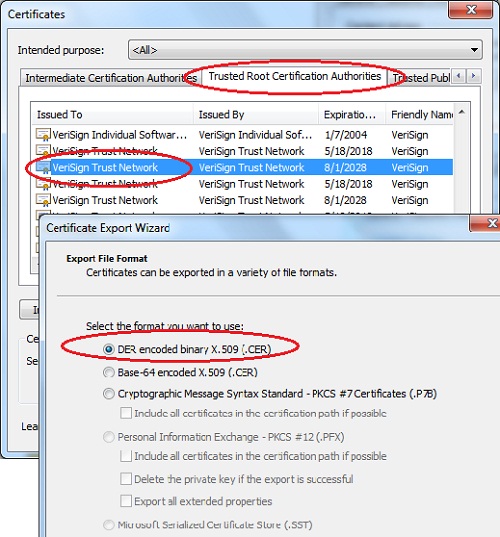Cryptography Tutorials - Herong's Tutorial Examples - v5.42, by Herong Yang
Exporting Certificates Out of IE
This section provides a tutorial example on how to use IE to export certificates installed in certificate stores into certificate files in DER and PEM formats.
In previous tutorial, we learned how to use IE to access certificates installed in certificate stores. Now let's see if we can export a certificate out of a certificate store into a certificate file.
1. Run IE in administrator mode and click the settings icon, then select "Internet Options". The Internet Options dialog box shows up.
2. Click the "Content" tab and the "Certificates" button. The Certificates dialog box shows up.
3. Click "Trusted Root Certification Authorities" tab. You should see a list of certificates that come with the IE installation. All certificates listed on this tab are automatically trusted.
4. Select "VeriSign Trust Network" with expiration date of 8/1/2028, and click the "Export" button. The Certificate Export Wizard shows up.
5. Click the "Next" button. The Export File Format step shows up with these options:
Certificate can be exported in a variety of file formats.
Select the format you want to use:
(.) DER encoded binary X.509 (.CER)
( ) Base-64 encoded X.509 (.CER)
( ) Cryptographic Message Syntax Standard
- PKCS #7 Certificates (.P7B)
6. Select "DER encoded binary X.509 (.CER)" as the export file format, and click the "Next" button. The File to Export step shows up.
7. Enter a file name: \verisign1.cer, and click the "Next" button. The confirmation step shows up.
8. Click the "Finish" button. The selected certificate will be exported into the specified file.
The picture below shows you some steps of the exporting process:

In the next tutorial, we will view the contents of the certificate from VeriSign Trust Network stored in a DER file, \verisign1.cer.
Table of Contents
Introduction to AES (Advanced Encryption Standard)
DES Algorithm - Illustrated with Java Programs
DES Algorithm Java Implementation
DES Algorithm - Java Implementation in JDK JCE
DES Encryption Operation Modes
PHP Implementation of DES - mcrypt
Blowfish - 8-Byte Block Cipher
Secret Key Generation and Management
Cipher - Secret Key Encryption and Decryption
RSA Implementation using java.math.BigInteger Class
Introduction of DSA (Digital Signature Algorithm)
Java Default Implementation of DSA
Private key and Public Key Pair Generation
PKCS#8/X.509 Private/Public Encoding Standards
Cipher - Public Key Encryption and Decryption
OpenSSL Introduction and Installation
OpenSSL Generating and Managing RSA Keys
OpenSSL Generating and Signing CSR
OpenSSL Validating Certificate Path
"keytool" and "keystore" from JDK
"OpenSSL" Signing CSR Generated by "keytool"
Migrating Keys from "keystore" to "OpenSSL" Key Files
Certificate X.509 Standard and DER/PEM Formats
Migrating Keys from "OpenSSL" Key Files to "keystore"
Visiting a "https" Web Site with IE
Installing Certificate Permanently in IE
Managing Certificates in Certificate Stores with IE
►Exporting Certificates Out of IE
OpenSSL Viewing Certificates Exported from IE
Importing CA Certificate into IE
Importing Certificate Path into IE